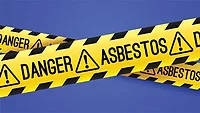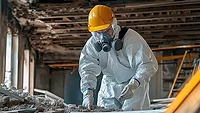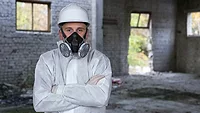Will Asbestos Ever Go Away?

Photo credit: shank_ali / E+ via Getty Images
For restoration companies, no, there is really no end in sight! Asbestos is still in some new building materials sitting on suppliers’ shelves and in existing buildings, especially those built in the ‘60’s and ‘70’s. Unfortunately for us as a contractors and employers, we have liability for how asbestos is handled on our jobs. In this article, I want to build some awareness, understanding, and clarity. Then, in future articles, I’ll give you more details on testing, analytical reports, and regulations.
The Basics
Wasn’t asbestos banned?
Yes, throughout the ‘70s, various specific materials were banned. Then in 1989, an overall asbestos ban was implemented, only to be overturned in October 1991. Other ban attempts were made in 2007 and 2008, which died on the vine.
A partial ban was implemented in 2019 and a proposed complete ban was introduced in 2022. However, that rule is still making its way through the approval process. (1)
Needless to say, the Environmental Protection Agency (EPA) has tried to ban asbestos, but has yet to completely do so.
What is the danger?
Asbestos materials are dangerous because they can be broken down into very, very small fibers that you can breathe directly into your lungs. We have no filter mechanism for fibers this small.

The damage comes after that – usually 10 to 30 years later in some people. It manifests itself as lung scarring, cancer, and sometimes the fibers can even work their way out of the lungs and into the body. In more rare instances, people can ingest asbestos fibers in a food or liquid and the fibers lodge in the digestive tract. Issues similar to breathing the fibers can develop from there. (2)
What materials are we talking about?
New building materials (3,4)
- Roof and siding shingles
- Adhesives and sealants
- Textured paint and patching compounds for walls and ceilings
- Vinyl floor tile
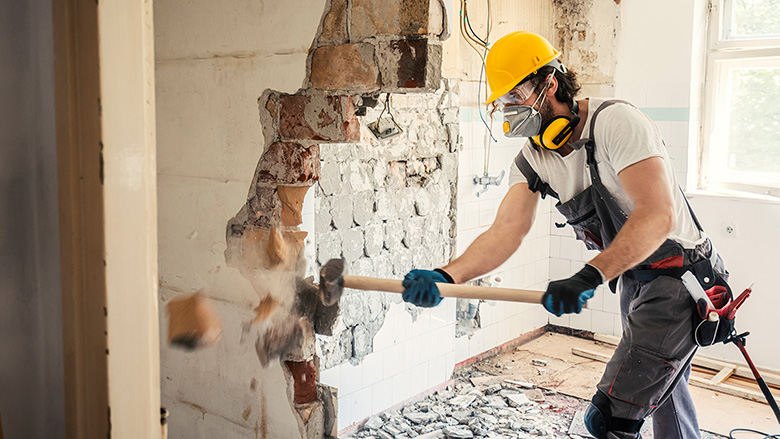
Building materials already in place
- Transite siding
- Adhesives, caulk, and mastic
- Vinyl flooring
- Plaster
- Popcorn ceilings
- Drywall joint compound
- Pipe insulation
- Roofing materials
The Not-So-Basics
Who regulates asbestos?
To keep the massive collection of regulations simpler, I break the regulators down into 3 categories, listed below. Then, for my simple mind, I picture each on the corner of a triangle. I call it the Asbestos Triangle. This has always helped me in the past when my head began spinning when trying to apply asbestos regulations.
OSHA Regulations
- Applies to all buildings, but protects the workers
- Can be the federal OSHA regs or state OSHA program regs
- Must presume thermal system insulation and surfacing material in pre-1980 buildings contain asbestos. (5) Some examples of this are:
- Thermal system Iisulation on pipes, tanks, etc.
- Sprayed/troweled on surfacing materials
- Decorative or acoustical plaster
- Popcorn ceilings
- Fireproofing materials
- Vinyl sheet or tile flooring
- Drop-ceiling tiles
- Transite siding
- Stucco siding
- Roofing, including shingles, mastic, and felt
- Must have these materials sampled and analyzed to rebut this presumption
EPA Regulations (6)
- Applies to “facilities”, regardless of year built (any structure, including condo’s or individual units operated as a residential cooperative, but excludes residential buildings with 4 or less dwelling units).
- Specifically prevents “disturbance” of materials that would cause asbestos fibers to release into the air.
- Must sample and analyze any suspect asbestos-containing materials before disturbance, removal, or demolition.
- Includes 10-day notifications, even if asbestos is not present, for removal of any load-bearing structure.
- Most states have an asbestos program, even if it just copies the EPA’s federal program. Some counties, cities, and municipalities have programs. (It all depends on how much funding they have!)
Licensing & Accreditation Entities
- Includes federal, state, county, city, and municipality requirements for handling or managing asbestos
- Varies state-by-state
- Licensing can include sampling, analysis, abatement, and transportation
- Accreditation is typically required when a specific license is not (e.g. asbestos sampling)
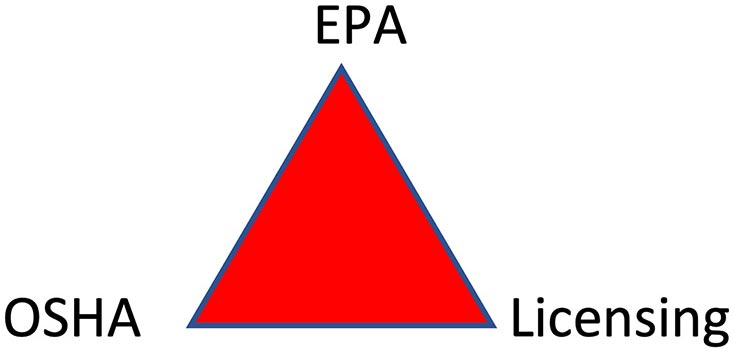
Who is liable?
For all OSHA regulations, the employer is liable for protecting their employees.
For most EPA regulations, the “facility” owner and the contractor have “joint and several” liability. That means they can each be held liable. (6) And in case you are wondering, yes, I have seen States and Counties fine a commercial building owner and then fine the contractor for asbestos regulation violations at the same building.
Notice who doesn’t have liability, but still may be involved in the restoration process – residential homeowners, insurance companies, and insurance adjusters!
Compliance
So where do I start with asbestos compliance?
I recommend establishing a relationship with three groups (remember that asbestos triangle?) that know your local asbestos regulations better than anybody else – your local/state EPA regulator, your local OSHA regulator, and your local asbestos consultant.
EPA Asbestos Regulators (also called NESHAP Regulators)
My personal experience is that your local or state asbestos regulators would much rather assist you with compliance and understanding than try to catch you violating a regulation and fine or prosecute you. Further, I have lost count of how many regulators think that restoration companies all perform asbestos abatement. Google search for your State, County, or City asbestos regulators. Reach out and contact them for help understanding your responsibilities. Many have great pamphlets and fliers that simplify what you need to do. (These are especially helpful when adjusters challenge why you sampled for asbestos!)
OSHA Asbestos Regulators
This will be your local OSHA Office – it may be a Federal or State Office. They will be focused on how you protect your employees and can help with that. Google search for OSHA offices in your area.
Asbestos Consultants
Your local asbestos sampling and/or consulting companies can be a gold mine of information for you. Why? First, their recommendations in a written report can limit your liability. Follow their direction and stay out of jail!
Second, they deal with local asbestos regulations every business day.
Third, they are usually licensed and accredited to do this work.
Here’s the key from my first point - you should be receiving written reports of the asbestos sampling results. In those reports, they should provide recommendations on how to manage the materials they sampled. This can range from “All Clear — proceed with removal” to “These materials should be avoided” to “These materials will require removal by a licensed abatement company.” I recommend you insist on receiving reports after asbestos sampling is performed. If your current sampling company doesn’t do that — strongly consider finding another company.
A few dollars saved on a cheaper company that doesn’t provide recommendations can cost you thousands later.
The asbestos topic is not going away and the risks are out there right now. In fact, as I mentioned, there are still building materials being imported with asbestos content. Given that and the multitude of regulations, Restoration companies should have solid asbestos management practices in place that don’t put employees and the business at risk.
Here are a few links to more information:
https://www.osha.gov/sites/default/files/publications/OSHA3507.pdf
https://www.epa.gov/asbestos/information-owners-and-managers-buildings-contain-asbestos
https://www.epa.gov/asbestos/state-asbestos-contacts
https://www.osha.gov/stateplans
https://www.randrmagonline.com/articles/87019-hazardous-building-materials-101
Reference:
- United States Environmental Protection Agency, EPA Actions to Protect the Public from Exposure to Asbestos: https://www.epa.gov/asbestos/epa-actions-protect-public-exposure-asbestos
- The National Institute for Occupational Safety and Health (NIOSH), Workplace Safety & Health Topics, Asbestos: https://www.cdc.gov/niosh/topics/asbestos/default.html
- Center for Disease Control, Agency for Toxic Substances and Disease Registry, Environmental Health and Medicine Education, Asbestos Toxicity, Where Is Asbestos Found?: https://www.atsdr.cdc.gov/csem/asbestos/where_is_asbestos_found.html#:~:text=Asbestos%20is%20still%20used%20in,buildings%20in%20the%20United%20States.
- United States Environmental Protection Agency, Asbestos, Learn About Asbestos: https://www.epa.gov/asbestos/learn-about-asbestos
- OSHA 29 CFR 1926.1101(b), Presumed Asbestos Containing Material definition: https://www.osha.gov/laws-regs/regulations/standardnumber/1926/1926.1101
- Florida Department of Environmental Protection, Asbestos FAQ: https://floridadep.gov/air/permitting-compliance/content/asbestos-faq#:~:text=The%20definition%20of%20a%20facility,exempt%20from%20the%20Asbestos%20NESHAP.
Looking for a reprint of this article?
From high-res PDFs to custom plaques, order your copy today!




